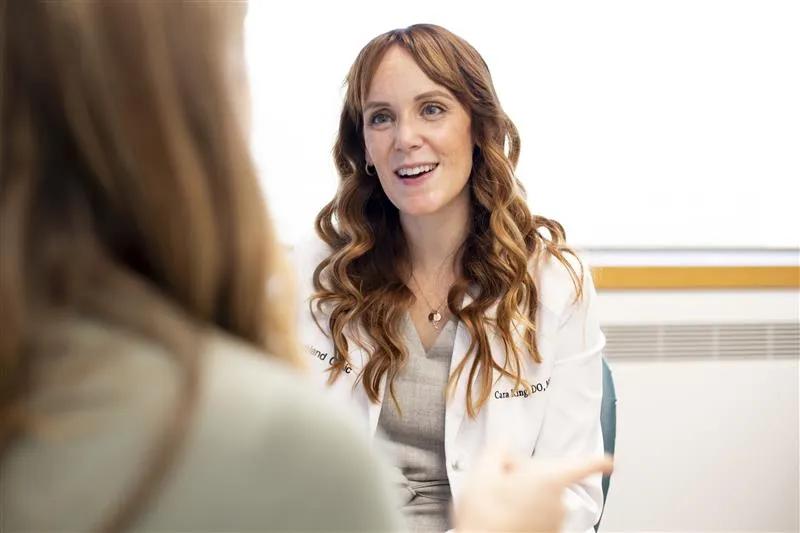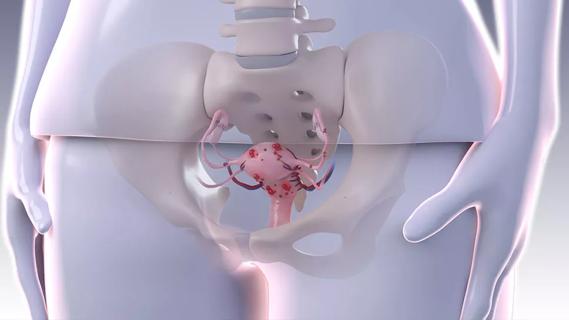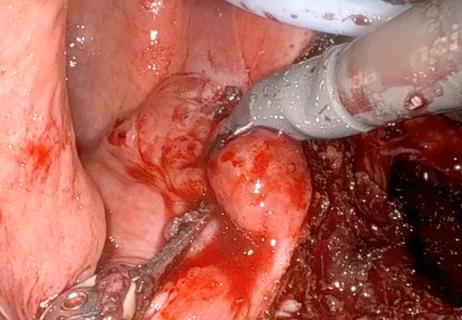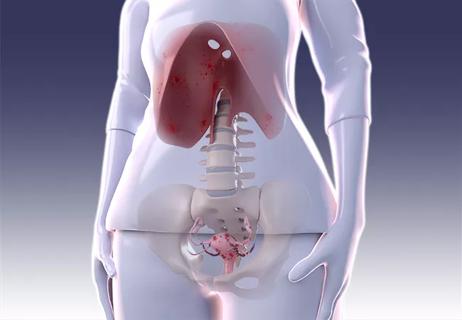Cara King, DO, MS, outlines practices that can make all the difference

A history of not being listened to can be one of the factors that makes endometriosis so difficult for those who have it. That’s why Cara King, DO, MS, begins patient conversations by letting them know what they’re feeling is real.
Advertisement
Cleveland Clinic is a non-profit academic medical center. Advertising on our site helps support our mission. We do not endorse non-Cleveland Clinic products or services. Policy
“The first thing I do is validate my patients about what they're feeling emotionally and physically. This is not in their heads,” says Dr. King, Section Head of Minimally Invasive Gynecologic Surgery and Medical Gynecology at Cleveland Clinic. “I believe everything they're saying to me, so that's the first thing I tell them, because for so many of them, they haven't been heard.”
Endometriosis affects an estimated 10% of women of reproductive age and is one of the leading causes of female infertility. Much remains unknown about what causes endometriosis, which arises when tissue similar to the uterine lining grows outside the uterus. But better outcomes have become possible, thanks to improvements in imaging techniques, approaches to care, and understanding of the wide variety of phenotypes.
“Endometriosis is staged from one to four,” says Dr. King. “Stage one is most superficial and stage four is most deeply infiltrative. Historically, we thought you started with stage one, and if you didn't address it, it slowly progressed to stage four. We don't have nearly enough research, but now we are seeing that some patients just stay at stage one their whole life. Some people go from stage one to stage four. And we've also seen that stage of disease does not dictate pain. Some people with stage one have terrible pain, and some with stage four don't really have pain.”
Despite all that is yet to be learned, Dr. King keeps six goals in mind to ensure patients with endometriosis may achieve the best outcomes.
Advertisement
Aim for an early and accurate diagnosis for all. On average, women with endometriosis wait seven to 10 years from symptom onset to diagnosis. “There's no blood test. Imaging is not perfect. It's becoming better, but not perfect,” Dr. King says. “Historically, the only way to confirm endo was surgically, which is higher risk. All of that can spiral into huge delays. And that presents problems because it can affect fertility. If we don't diagnose and treat it early, it can lead to people being unable to achieve pregnancy because of disease progression.”
Delays also often equal more time spent struggling with pain, which in turn can lead to more complex pain responses.
Access to good care or to specialized surgeons also has typically been more difficult for women with certain backgrounds or challenges to accessing care. These patients are more likely to have had delayed diagnosis or, when diagnosed, are less likely to receive fertility-preserving care.
It’s important, then, to keep endometriosis in mind when patients present with unexplained chronic pelvic pain, and to connect them with specialists who have expertise in the disease.
Create personalized treatment plans. All patients should be empowered to share in decision making with their treatment providers and treatment plans that center their needs and priorities. The key question is whether the person prioritizes a need for pain relief, which sometime can be achieved with birth control medication, or hopes to become pregnant.
Advertisement
“Every treatment plan we make is tailored to the patient's journey of reproductive health, pain management, and quality of life,” Dr. King says. “The patient is an expert in their own experience. Nobody knows their body more or their own journey more or their goals more than patients themselves. So valuing that is really important.”
Improve access to expertise. In the absence of standardization of care, it is critical to connect patients with physicians who are highly experienced in identifying and treating endometriosis.
“The variations in surgical care among patients, depending upon which surgeon they see, are huge. Finding a team that does high-volume care, that specializes in endometriosis, that has a multidisciplinary team with colorectal surgery, urology and cardiothoracic experience, is critical to outcome optimization,” says Dr. King.
Likewise, that team should understand the importance of preoperative imaging.
“Imaging has not been very good at diagnosing endometriosis, but we are actually to a point now where we can get more detailed imaging that allows us to diagnose endo quite accurately. And so having accurate pre-op imaging is critical, as is counseling. I like to be able to tell the patient what I think I'm going to find, and get their feedback: I think you have a big bowel lesion. Do you want me to excise that or not? Because that surgery may be very big with a bowel resection, ostomy bag, et cetera.”
Imaging also informs decisions about what equipment and human resources will be needed and where the surgery will take place — in a hospital or a surgery center.
Advertisement
Consider all the contributors to the patient’s pain. As a chronic condition, endometriosis is often a source of chronic pain that can affect every facet of individuals’ lives. Treatment, then should address that.
“Even if I do the most perfect excision of endometriosis, that may not fix everything because patients often have had so many years of pain generation,” says Dr. King. “So we really need to optimize them before and after surgery by looking at them as a whole — their mental health, behavioral health, pelvic floor, physical therapy, functional medicine, nutrition, anesthesia and pain medicine.”
Structural barriers should be addressed as well, she adds. “How do we help patients who have transportation issues or childcare issues, for example. Can we provide care in a virtual fashion, or otherwise meet people where they are? We also need to provide trauma-informed care, because a lot of these patients have been gaslit forever about where their pain is really coming from. And that really stemmed from lack of research in endometriosis, and women's care in general, and physicians not knowing what they didn't know.”
Support reproductive and life goals equitably. Not every patient is focused on fertility. Some patients put a high value on it. It’s important to value fertility when that is desired, bring the topic up early in the conversation, and hear and respect the patient’s life goals.
“We can incorporate our reproductive endocrinology and infertility doctors early and help optimize patients even if they're not ready for pregnancy right now,” says Dr. King. “On the flip side, we should not be telling a patient that if they get pregnant, their problem will be solved. We can meet patients where they are by valuing reproduction without forcing reproduction.
Advertisement
Manage expectations. Once a patient is diagnosed, they will have to manage endometriosis on a lifelong basis. Good counseling includes communicating realistic expectations.
“Repeat surgery is sometimes required even with the best excision surgery, depending on the aggressiveness of the disease and the amount of size of the original surgery,” says Dr. King. “I think it's important to get out of our silos. I'm a GYN surgeon. I'm very good at my GYN surgery, but if I don't broaden my viewpoint, then the patient won't feel better long-term. We also have to target musculoskeletal issues, neuropathic changes, central sensitization, the psychological component of this, bladder and bowel symptoms and more.
“I let patients know we have to calm down their nervous system, which is often fired up because their nerves have remodeled to their pelvis. We may do work with pelvic floor PT,” she adds. “We have to work on some of the neuropathic changes that have happened. I try to do that a little bit before surgery, then do surgery, and then from there, work more to reset to a new norm.”
One of the messages patients should hear is that the healing process isn't always linear. Feeling better can be followed by plateaus.
“It’s almost like layers of an onion, where we keep taking off layers until we get to the core,” she says. “And this could be a long journey, but we'll get you there.”
Advertisement

A multidisciplinary approach facilitates timely diagnosis and better treatment

Better screening can improve GI outcomes and reduce costs

Counseling and careful surgical considerations are key

A large nodule had strangulated the patient’s ureter and invaded the vagina, bladder and rectum

Case study: Concomitant robot-assisted surgery without repositioning the patient

ACOG-informed guidance considers mothers and babies

Prolapse surgery need not automatically mean hysterectomy

Artesunate ointment shows promise as a non-surgical alternative